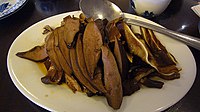Pig's ear (food)
| Pig's ear | |||||||||||

|
|||||||||||
| Traditional Chinese | |||||||||||
|---|---|---|---|---|---|---|---|---|---|---|---|
| Simplified Chinese | |||||||||||
| Literal meaning | pig's ear | ||||||||||
|
|||||||||||
| Transcriptions | |
|---|---|
| Standard Mandarin | |
| Hanyu Pinyin | zhu1 er3 |
| Yue: Cantonese | |
| Jyutping | zyu1 ji5 |
Pig's ear, as food for human consumption, is the cooked ear of pig. It is found in a number of cuisines around the world.
In Bulgaria, pig's ear is used like an appetizer for beer or wine. It is first boiled and then grilled, served with lemon, soy sauce, salt and ground pepper.
In Chinese cuisine, pig's ear is often an appetizer or a side dish, called 豬耳朵 (pinyin: zhū ěr duo, "pig's ear"). Pig's ear can be abbreviated in Chinese to simply 豬耳. In some regions, pig's ears are known as 层层脆 (ceng ceng cui, literally "layers of crunch"). It can be first boiled or stewed, and then sliced thin, served with soy sauce or spiced with chili paste. When cooked, the outer texture is gelatinous, akin to tofu, and the center cartilage is crunchy. Pig's ear can be eaten warm or cold.
In Cantonese cuisine, it is another ingredient used in lou mei. The emphasis is on using all edible parts of the pig. Pigs' ears (and lou mei in general) are not considered as delicacies.
In the Philippines, the dish known as Sisig may sometimes use pig ears as part of its ingredients
Pig's ear, known in Lithuania as kiaulės ausis, is served either smoked and cut into thin strips as a beer snack, or boiled whole and served as the main dish with horseradish and fresh vegetables or pickles.
In Okinawan cuisine, the pig's ear is called mimigaa (ミミガー). It is prepared by boiling or pickling and is served with vinegar or in the form of sashimi (sliced raw meat). The entirety of the pig's face is also eaten in Okinawa, where it is known as chiragaa (チラガー).
In Spanish cuisine, pig's ear is served roasted as Oreja de Cerdo, one of the tapas snacks, or boiled in many variants of stew and cocido.
...
Wikipedia
